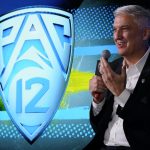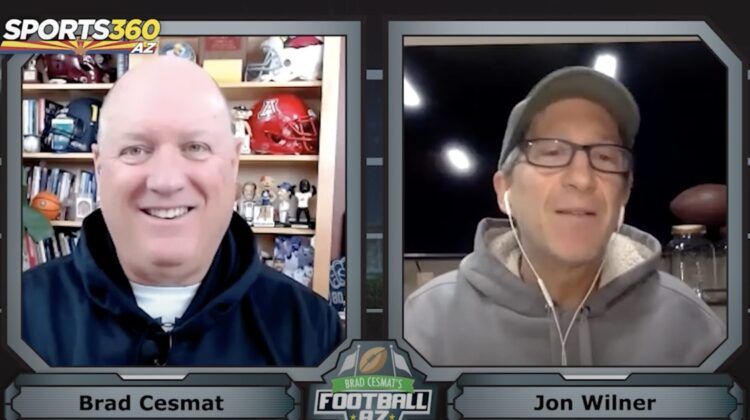The Hotline mailbag publishes weekly. Send questions to pac12hotline@bayareanewsgroup.
Please note: Some questions have been edited for clarity and brevity.
Why does commissioner George Kliavkoff seem to bear the brunt of displeasure when, in fact, his predecessor, Larry Scott, and the university presidents have their fingerprints all over a decade of bad decisions? — Jim Varnell
It depends on the source of your information. Some blame Kliavkoff because he’s the easiest target. The Hotline has been unwavering in placing the majority of responsibility for the Pac-12’s collapse on the presidents.
In our view, there is zero debate about their outsized portion of culpability.
Scott and Kliavkoff were deeply flawed and made a litany of strategic miscalculations, but both reported to, and took direction from, the presidents.
As we noted on Twitter/X recently, the blame breakdown looks like this:
Presidents: 51 percent
Kliavkoff: 25 percent
Scott: 24 percent
Scott created the circumstances for collapse with misguided tactics over a dozen years. Kliavkoff was hired to avert disaster but, in fact, was wholly ill-equipped for the task. But always, the president ruled the kingdom with a destructive mix of arrogance, ignorance and indifference.
They didn’t care about college football; they didn’t understand college sports; and they carried an inflated view of their schools’ value in the media rights game.
(Also, the presidents were so convinced nobody would ever leave the grand and glorious Pac-12 that they didn’t bother implementing exit penalties.)
The presidents allowed Scott to operate with a conference-first approach to spending and governance when the campuses should have been the priority all along.
This led to mistrust, frustration and wandering eyes in Los Angeles.
They overcompensated for Scott’s style by hiring a nice-guy replacement, Kliavkoff, who wouldn’t cause any friction. In reality, that was a poor model to navigate the roiling landscape to come.
Heard your podcast on how Kliavkoff was a bad commissioner. In hindsight, do you think the Big 12’s Brett Yormark could have done as good a job there as he’s done in the Big 12? — @vakaviti
We have written about Kliavkoff and Yormark numerous times over the past 20 months — they will be paired together in realignment history as loser and winner, respectively — but let’s summarize our view. With this topic, context is crucial.
Above all, readers should recognize that it’s not an apples-to-apples comparison because they inherited completely different situations.
The Big 12 already had been gutted by the loss of Texas and Oklahoma (to the SEC) and fortified by the shrewd decision to expand (with BYU, UCF, Houston and Cincinnati) before Yormark took over.
At the point he arrived, in the summer of 2022, the Big 12 was both devoid of schools coveted by the SEC or Big Ten and stocked with presidents and athletic directors who prioritized survival and stability over all else.
Kliavkoff took charge of the Pac-12 before it was gutted and faced a lineup of presidents with competing agendas, wandering eyes, little desire to expand and a desire for the most lucrative media rights contract possible.
Even after the L.A. schools departed — and Kliavkoff certainly bears some responsibility for that — the difficult dynamics remained: The Pac-12 still had two schools valued by the Big Ten (Oregon and Washington) and an array of presidents who prioritized cash over survival.
Kliavkoff failed to properly manage the process, but it was more complicated and challenging than the situation Yormark inherited.
Put another way: Kliavkoff was dealt a bad hand and played it poorly; Yormark was dealt a good hand and played it well.
Yormark had another advantage — one of his own making: He hustled.
He understood the urgency baked into the media rights negotiations; Kliavkoff never did.
He understood that college sports is a relationship business; Kliavkoff never did.
He realized the realignment rock fight required rocks; Kliavkoff brought a teddy bear.
Would the Pac-12 be intact today if the presidents had hired Yormark in the spring of 2021?
The Hotline loves alternative history — as noted on the podcast, I could ride the wormhole all the way back to the South winning Gettysburg. Gaming out the past three years with Yormark as Pac-12 commissioner is a fascinating topic.
Yormark’s innate hustle (urgency) certainly would have given the Pac-12 a better chance to survive. But I don’t think you can state definitively either way because, once again, so much depended on the mindset of the presidents — and those in the Pac-12 carried that unique, destructive combination we mentioned earlier: arrogance, ignorance and indifference.
Also, the Pac-12 presidents would never have hired Yormark, a relentless salesman unafraid to push the envelope.
After the Scott era, they wanted someone who carried a teddy bear and a smile, who was compliant and affable.
Sure, that was a colossal mistake. But at the time, the Pac-12 presidents didn’t realize the realignment rock fight was coming.
How well do you think Cal and Stanford played their cards during realignment? They joined a very unstable conference on the other side of the country at an extreme discount. Could they be left out in the cold again? — @Wazzucoug1996
The Bay Area schools were caught by surprise when the Pac-12 collapsed, according to multiple sources at the time. Stanford president at the time, Marc Tessier-Lavigne, and Cal chancellor Carol Christ had believed all was well and the Pac-12 grant-of-rights agreement would be signed.
(Tessier-Lavigne was one of the presidents who pushed Kliavkoff to pursue a $50 million-per-school deal from ESPN, by the way.)
When everything fell apart on Aug. 4, the schools had to scramble.
The Big Ten didn’t want them — that’s a column topic unto itself — so they turned to the ACC despite the obvious logistical nightmare of belonging to a conference based on the opposite coast.
The ACC made sense on three levels: 1) institutional alignment (i.e. academics), 2) the number of Cal and Stanford alumni on the East Coast and 3) the quality of competition for the schools’ vaunted Olympic sports.
But ACC membership makes no sense for the welfare of the athletes.
Also, the schools were required to sign a 12-year grant-of-rights contract at a steep revenue discount with a conference rocked by Florida State’s legal challenge to that very contract.
What else could the Cardinal and Bears have done? One source suggested they should have hit pause before joining the ACC in order to assess their options in a rebuilt Pac-12 with Washington State and Oregon State.
In that scenario, the source noted, Stanford would have served as the anchor — not only for a media rights deal but also for retaining Power Five status with the College Football Playoff. (It would have been difficult for other leagues to argue the ‘Pac-4’ wasn’t a power conference when it included the school with the most NCAA championships.)
Given a few months, the thinking goes, the ‘Pac-4’ could have pieced together competition schedules with other leagues that would have satisfied their needs.
And crucially, it would have bought them time to allow the ACC’s legal fight to play out, along with all the massive, inevitable changes at the NCAA level.
Question about the news regarding the departing 10 schools still playing in the Pac-12 bowls (Alamo, Sun, Vegas, Holiday, etc): Do the Pac-2 schools still keep all the money from all the bowl games? — @CelestialMosh
The bowls mentioned provide very little return for the schools once expenses have been accounted for. The big dollars flow from the lineup of New Year’s Six games, which includes the CFP.
Every Power Five school receives about $5 million annually from the CFP. The Pac-12 also has a contract with the Rose Bowl that pays approximately $40 million each year and will remain in place for the next two football seasons.
That income will account for a large portion of the cash used by WSU and OSU to maintain their athletic department operations and, potentially, rebuild the conference.
Any idea on how the old Pac-12 bowls will select the representatives from the Big Ten and Big 12? — @RockDawg3
The Hotline has not confirmed the plan, but my sense is that the bowls and the conferences want to avoid as much disruption to the selection process as possible.
Because the process is going to be disrupted enough by the expanded playoff.
And because the bowl tie-ins are based on existing geography.
It makes little sense for West Coast teams that aren’t part of the CFP to participate in bowl games in the Eastern Time Zone. It’s a burden for fans, and ticket sales will suffer.
The Pac-12’s outbound schools are much better off playing in San Diego, L.A. and Las Vegas than Charlotte, Detroit and Birmingham, for example.
The conferences also don’t want their current teams to be displaced from regional bowls — and sent to the West Coast — by the Pac-12 newcomers.
Is there any method of measuring name, image and likeness funding per player, school, position — and from what source? So many wild dollar figures are thrown around, is there a definitive ranking? — @jkparker2000
I can offer you one website and a few words of caution.
On3.com tracks NIL closely and has a drop-down tab that provides information on specific deals.
But take caution: Unless you see the contract, be skeptical of all dollar figures attached to NIL deals, whether the source is On3, social media or reports by mainstream media outlets.
The vast majority of NIL deals carry inaccurate values, because inflated price tags serve the agents brokering the deals and the collectives signing the athletics.
We’ve seen changes throughout college football. Should there be top-25 rankings reform, too? If not, the Big Ten and SEC will always enter each season with a reputation advantage and suffer less movement from losses. — @alpha1906
Terrific question, but as a longtime voter, I’m not sure how you could “reform” the Associated Press poll, for example. Adding an algorithm that somehow accounted for conference affiliation would strip the AP poll of its human element.
Each year, the AP implores voters to disregard preseason hype and vote based on results.
And each year, preseason hype plays a significant role in the poll, especially early in the season.
Hopefully, voters will approach the consolidated power conferences with enough objectivity that the on-field results will matter. And in that regard, the non-conference matchups should play a significant role.
Is it time for the Wayne Tinkle show to end at Oregon State? There was supposed to be improvement this year. I’ve been supportive of Tinkle, but even I can see that the game plans just aren’t working. — @LeadfootBeav
It’s long past time, in our estimation.
Tinkle was on the verge of getting fired when the Beavers unleashed a magical three-week run in March 2021 that earned him a massive extension and raise.
OSU remains paralyzed by that deal, which runs through the 2026-27 season and carries a buyout of $8.7 million, according to the Oregonian.
At some point, the Beavers must determine whether the cost of retaining Tinkle is greater than the cost of eating the contract.
As we noted earlier this month, Tinkle is one of several Pac-12 coaches on the Hot Seat as the stretch run unfolds.
Can we get a breakdown of all the coaching changes for assistants and what buyouts were actually paid? For example: What did Alabama pay for the Washington coaches? — @Huskygrad96
Once the contracts are settled and publicly available, we will dive into the issue.
The chain reaction set off by a single coach retiring — especially if you include all the player movement associated with the decision — is remarkable.
Then again, Nick Saban was not like other coaches.
*** Send suggestions, comments and tips (confidentiality guaranteed) to pac12hotline@bayareanewsgroup.
*** Follow me on Twitter/X: @WilnerHotline
*** Pac-12 Hotline is not endorsed or sponsored by the Pac-12 Conference, and the views expressed herein do not necessarily reflect the views of the Conference.
ReplyReply allForward |
Related posts:

Arizona guard Cedric Henderson Jr. (45) shoots against Stanford forward Brandon Angel (23) during the second half of an NCAA college basketball game Saturday, Feb. 11, 2023, in Stanford, Calif. (AP Photo/Josie Lepe)
Pac-12 rewind: Stanford stuns Arizona, UCLA thumps Oregon, ASU sweeps the Bay Area and more
(AP Photo/Ralph Freso, File)
Pac-12 media rights negotiations: Process nears completion as survival odds remain unchanged Hotline mailbag: The problem with partial shares for Oregon and UW (in the Big Ten), pondering Tulane and Rice, a Pac-8 and more
Hotline mailbag: The problem with partial shares for Oregon and UW (in the Big Ten), pondering Tulane and Rice, a Pac-8 and more 
(AP Photo/Marcio Jose Sanchez)
Hotline mailbag: ‘Worst-case scenario’ for the Pac-12, outlook for Oregon and UW, valuation rumors, expansion candidates and more
